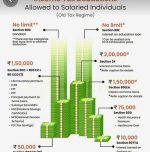Flexible tax regime choices for salaried employees

In India, salaried employees face a critical financial decision annually: choosing between the old and new tax regimes to optimize their tax payments.
The choice between these regimes influences how Tax Deducted at Source (TDS) is calculated on their salaries.
However, despite the initial selection, employees retain the flexibility to switch regimes when filing their Income Tax Returns (ITR).
The distinction between the two tax regimes stems from the Union Budget 2020. The new regime offers lower tax rates but removes many deductions and exemptions available under the old regime.
This simplicity appeals to those with fewer deductions, while the old regime may benefit those with significant deductible expenses.
For TDS purposes, employees must declare their preferred tax regime to their employers once a year, typically through internal portals or HR forms.
This decision dictates how taxes are withheld from their salary throughout the financial year. It’s crucial to note that the new tax regime is assumed as the default if no selection is made.
Interestingly, the choice made for TDS is not final regarding filing the ITR. Employees have the opportunity to reevaluate and change their tax regime at the time of filing their returns.
This option is invaluable as it allows taxpayers to reassess their financial situation and deductions, potentially opting for a regime that offers a lower tax liability after considering their entire financial picture for the year.
Switching between tax regimes during ITR filing is straightforward and requires no additional forms. Taxpayers simply select their preferred regime, old or new—directly on the ITR form.
This process provides a final opportunity to adjust one’s tax strategy, offering a chance to reduce tax liability based on the actual data of income and deductions for the year.
It is advisable for taxpayers to carefully assess their financial details and potential deductions under both tax regimes before finalizing their choice on the ITR.
This strategic decision can lead to substantial tax savings and align more closely with an individual’s financial goals and circumstances, making it a critical aspect of annual financial planning for every salaried employee in India.
Photo by Austin Distel on Unsplash (Free for commercial use)
Image Reference: https://unsplash.com/photos/turned-on-macbook-goFBjlQiZFU









Leave a Reply